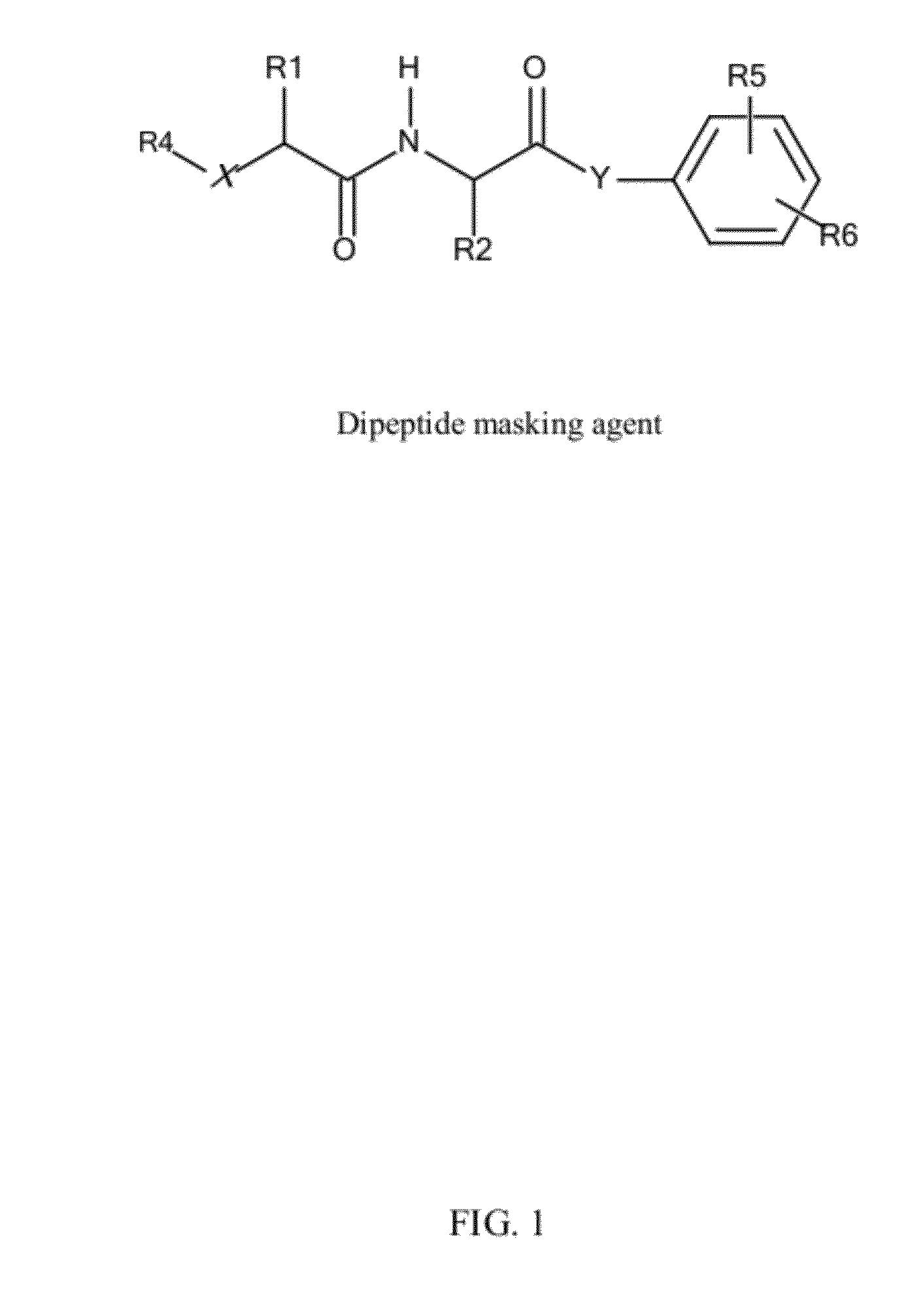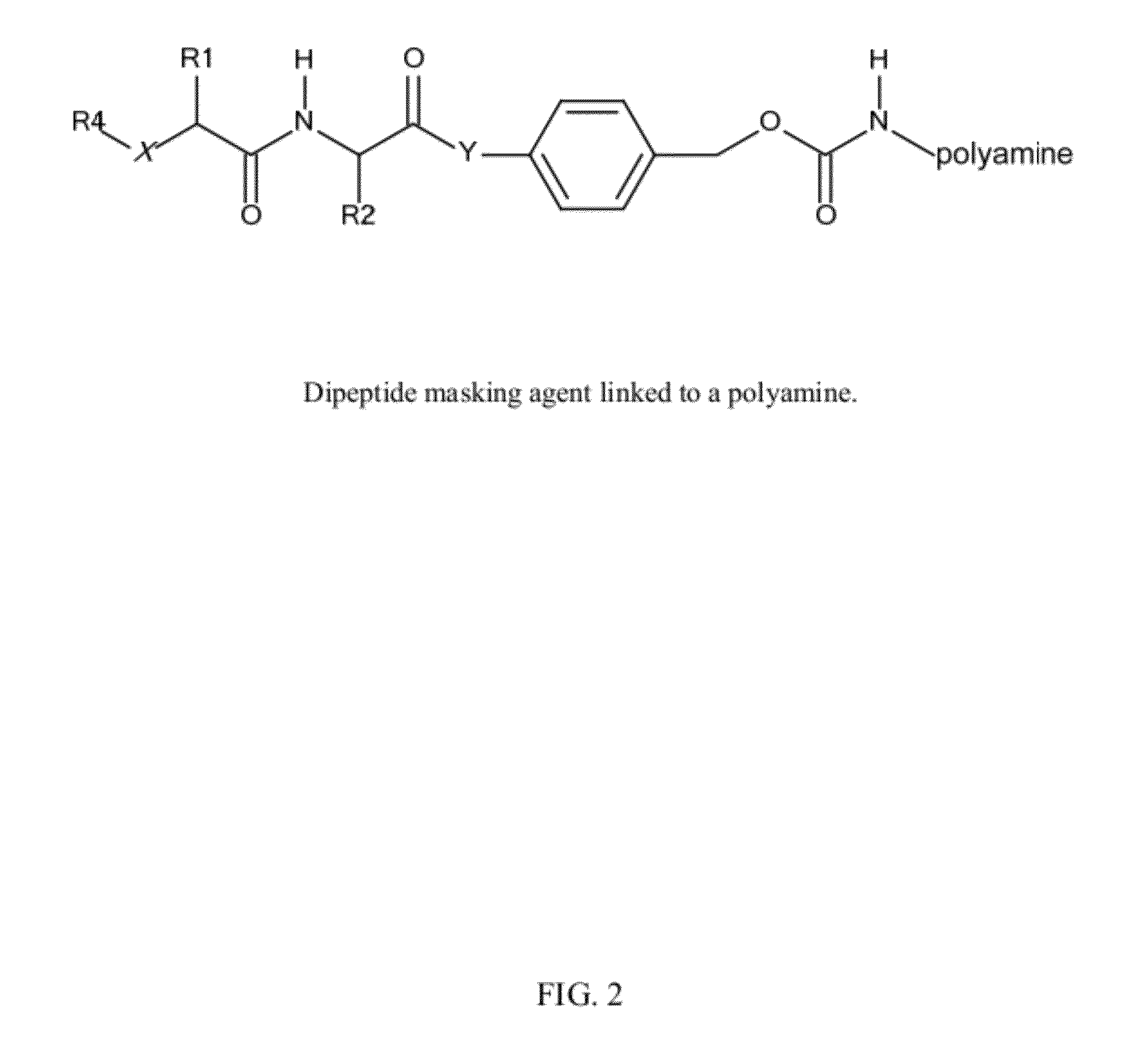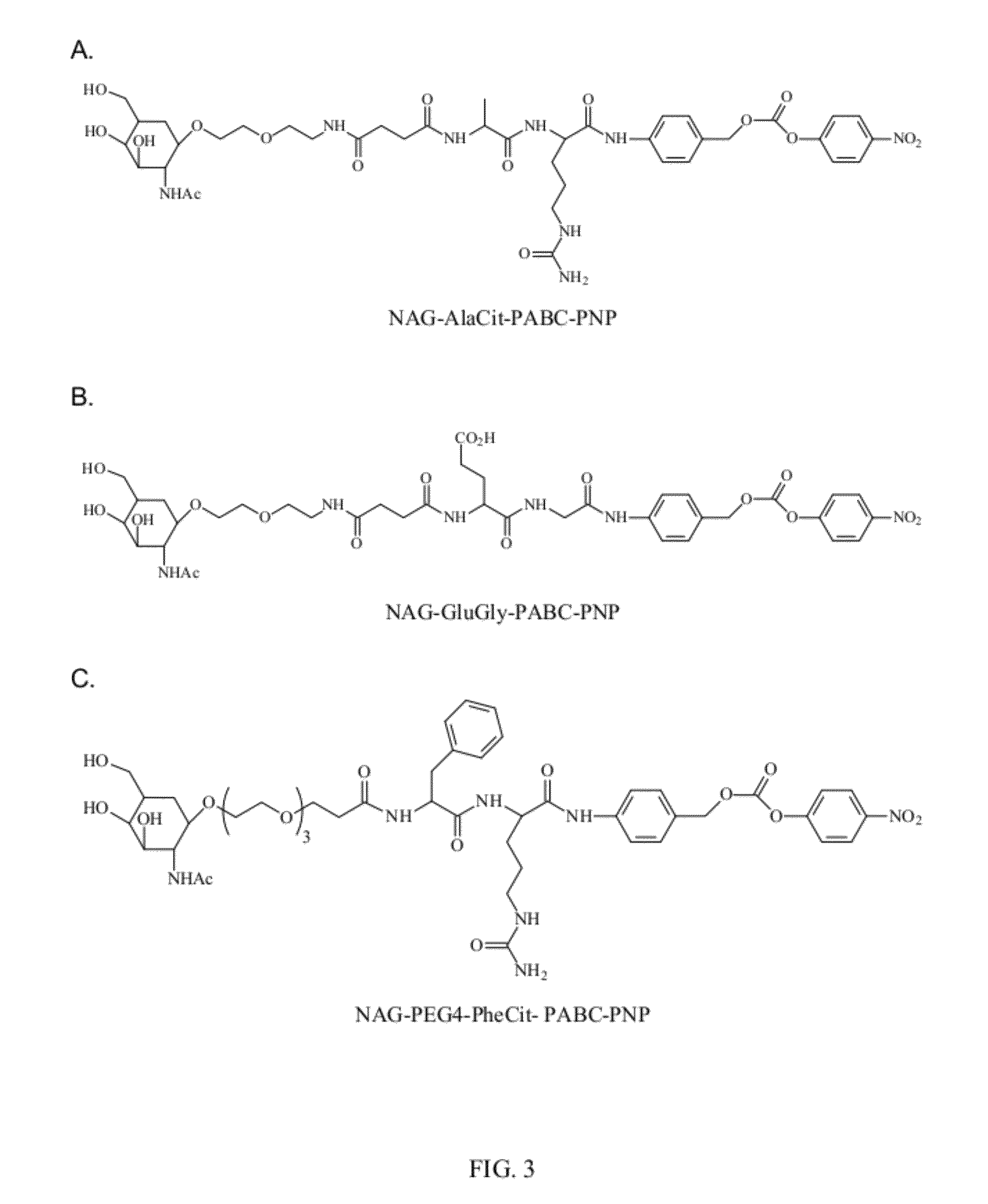In vivo polynucleotide delivery conjugates having enzyme sensitive linkages
a polynucleotide and conjugate technology, applied in the direction of dna/rna fragmentation, peptides, drug compositions, etc., can solve the problems of prohibitively large nucleic acid dose required with these methods, large hydrophilic polymers used in antisense, rnai, gene therapies, etc., to inhibit endogenous gene expression, rnai, and reduce the effect of rnai
- Summary
- Abstract
- Description
- Claims
- Application Information
AI Technical Summary
Benefits of technology
Problems solved by technology
Method used
Image
Examples
example 1
Synthesis of Protease (Peptidase) Cleavable Masking Agents
[0164]All reactions, except coupling of amino acids in aqueous NaHCO3 and silyl-group deprotection, were carried out in anhydrous conditions using fresh anhydrous solvents. Column purification was done on a silica gel using specified eluents. Mass-spectra (MS) were taken using electrospray ionization.
[0165]In preparation of active p-nitrophenyl-p-acylamidobenzyl carbonate derivatives of NAG and PEG (NAG-L-AA-PABC-PNP and PEG-AA-PABC-PNP) we utilized NHS ester of respective PEG or NAG-containing derivatives to acylate amino terminus of dipeptido-p-acylaminobenzy alcohol precursor. In the following steps benzylic hydroxyl group was converted into p-nitrophenyl carbonate followed by removal of protective groups from amino acids and NAG moiety. In some applications, when paranitrophenol (PNP)-carbonates were used for modification of certain polymers, protective groups prior to polymer modification.
[0166]
R comprises an ASGPr ligan...
example 2
Linkage of Protease Cleavable Masking Agents to Amine-Containing Polymers—Formation of P-Acylamidobenzyl Carbamate Linkages
[0337]A. Modification of Melittin with Protease Cleavable Masking Agents.
[0338]1×mg of melittin peptide and 10×mg HEPES base at 1-10 mg / mL peptide was masked by addition of 2-6×mg of amine-reactive p-nitrophenyl carbonate or N-hydroxysuccinimide carbonate derivatives of the NAG-containing protease cleavable substrate. The solution was then incubated at least 1 h at room temperature (RT) before injection into animals.
[0339]B. Modification of Polyamines with Protease Cleavable Masking Agents.
[0340]Activated (amine reactive) carbonates of p-acylamidobenzyl alcohol derivatives are reacted with amino groups of amphipathic membrane active polyamines in H2O at pH>8 to yield a p-acylamidobenzyl carbamate.
[0341]
R1 comprises an ASGPr ligand (either protected or unprotected) or a PEG,
R2 is an amphipathic membrane active polyamine,
AA is a dipeptide (either protected or unpr...
example 3
siRNAs
[0343]siRNAs had the following sequences:
[0344]
Factor VII siRNAsense:(Seq ID 1)(Chol)-5′ GfcAfaAfgGfcGfuGfcCfaAfcUfcAf(invdT) 3′antisense:(Seq ID 2)5′ pdTsGfaGfuUfgGfcAfcGfcCfuUfuGfcdTsdT 3′orsense:(Seq ID 3)5′ GGAUfCfAUfCfUfCfAAGUfCfUfUfACfdTsdT 3′antisense:(Seq ID 4)5′ GUfAAGACfUfUfGAGAUfGAUfCfCfdTsdT 3′orsense:(Seq ID 5)(NH2C6)GfuUfgGfuGfaAfuGfgAfgCfuCfaGf(invdT) 3′antisense:(Seq ID 6)pCfsUfgAfgCfuCfcAfuUfcAfcCfaAfcdTsdT 3′orsense:(Seq ID 23)5′ (NH2C6)uGuGfcAfaAfgGfcGfuGfcCfaAfcticAf(invdT) 3′antisense:(Seq ID 24)5′ pdTsGfaGfuUfgGfcAfcGfcCfuUfuGfcdTsdT 3′Factor VII siRNA(primate)sense:(Seq ID 7)(chol)-5′ uuAGGfuUfgGfuGfaAfuGfgAfgCfuCfaGf(invdT) 3′antisense:(Seq ID 8)5′ pCfsUfgAfgCfuCfcAfuUfcAfcCfaAfcdTsdT 3′ApoB siRNA:sense:(Seq ID 9)(cholC6SSC6)-5′ GGAAUCuuAuAuuuGAUCcAsA 3′antisense:(Seq ID 10)5′ uuGGAUcAAAuAuAAGAuUCcscsU 3′AhaI siRNA:sense:(Seq ID 11)(NH2C6)GfgAfuGfaAfgUfgGfaGfaUfuAfgUf(invdT) 3′antisense:(Seq ID 12)pdAsCfuAfaUfcUfcCfaCfuUfcAfuCfcdTsdT 3′Luc siRNAsense:(S...
PUM
| Property | Measurement | Unit |
|---|---|---|
| diameter | aaaaa | aaaaa |
| diameter | aaaaa | aaaaa |
| molecular weight average | aaaaa | aaaaa |
Abstract
Description
Claims
Application Information
 Login to View More
Login to View More - R&D
- Intellectual Property
- Life Sciences
- Materials
- Tech Scout
- Unparalleled Data Quality
- Higher Quality Content
- 60% Fewer Hallucinations
Browse by: Latest US Patents, China's latest patents, Technical Efficacy Thesaurus, Application Domain, Technology Topic, Popular Technical Reports.
© 2025 PatSnap. All rights reserved.Legal|Privacy policy|Modern Slavery Act Transparency Statement|Sitemap|About US| Contact US: help@patsnap.com



